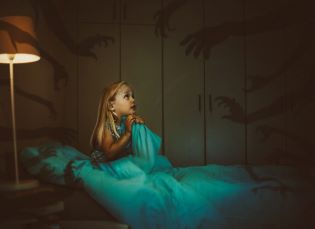Going Out to Dinner with Kids While on a Sleep Schedule
Night Terrors vs Nightmares: Sleep Expert Recommended Solutions
Night terrors are different from nightmares in both symptoms and experience, so it is important to determine what your child is experiencing so that you can respond accordingly.
Nightmares
Nightmares occur during REM sleep, which happens near the end of our sleep period. Because of this, nightmares typically happen during the second half of the night. When children have a nightmare, they will seek comfort after they wake. They are able to recall the nightmare but it can take a while to fall back asleep and get the thoughts out of their mind.
Nightmares are fairly common in children ages 2-4 and are a normal part of development. This is the age when normal fears develop and imaginations expand. Children this age often have difficulty distinguishing between reality and fantasy. Many things can cause stress, and then nightmares, at this age, from potty training to moving to a big kid bed. A new sibling or changes in childcare can also trigger these. As a child ages, they can continue to be impacted by nightmares (ages 5 – 8) because they are starting to try to comprehend real life dangers such as car accidents or death.
Sleep Wise recommendations for reducing nightmares:
- 1. Have a relaxing and predictable bedtime routine (warm bath, uplifting story, etc.)
- 2. Play calm or quiet family games before bed.
- 3. Avoid scary videos, books, shows prior to bed.
- 4. Put your child to bed early. Overtiredness can cause nightmares.
- 5. Avoid high-dose vitamins at bedtime.
- 6. Check with your pediatrician to make sure your child is not on any medications
that might be interfering with his night sleep.
How to Respond to a Nightmare

When your child has a nightmare, respond quickly. Hugs or back rubs can be very helpful until the child calms down. If your child wants to talk about the nightmare, that is okay but don’t press the issue. At this age, your child will understand the difference between reality and fantasy so consoling him by reminding him “it’s only a dream” will be helpful. Be patience if he is still upset. It can take him awhile to calm down. If your child does not have a comfort item, this might be a great time to introduce one.
Nightmares can often bring a fear of the dark. If having some light in your child’s room will bring comfort, I recommend using a nightlight with an amber glow. These are my favorite because they do not emit any blue light which can inhibit sleep. During the daytime or evening hours, make being in the dark fun: play flashlight tag, search for things that glow in the dark, etc. Many parents have tried “Monster Spray” however, I don’t recommend this. I find that it can add to the anxiety that there could actually be monsters in your child’s room. Introducing a lavender scented “Sleep Spray” or a “Dream Spray” is a more positive solution.
Night Terrors
Night terrors are very different from nightmares. Night terrors occur during non-REM sleep and typically occur within 2-3 hours of going to sleep. Night terrors are not bad dreams. When your child is having a night terror, they could sweat or have a racing heartbeat. They may scream and appear anxious. They typically do not recognize you when you approach them. This child is often inconsolable. Night terrors can last between 5-15 minutes. It’s often much more upsetting for the parents than the child because children typically do not remember them.
Night terrors occur in about 2% of all children. They are not a sign of a psychological problem. The most common cause of night terrors is sleep deprivation or a disturbance in your child’s typical sleep patterns (i.e. a later bedtime, new home, traveling to a new time zone). Sleep apnea or fevers can also cause night terrors.
Sleep Wise Recommendations for Navigating Night Terrors:
- 1. Monitor your child but avoid interfering as that can worsen the episode
- 2. Make sure your child is physically safe during the night terror
- 3. Keep a regular sleep schedule for your child.
- 4. Put your child to bed earlier.
- 5. Don’t talk about the terror with your child that night or the next morning
If night terrors are happening around the same time each night, we recommend logging your child’s sleep. You can also try to wake your child up 15 minutes prior to the night terror for a “reset”. If you do this for about a week, you may see the night terrors diminish.
Night terrors and nightmares, can be upsetting disturbing for parents and children, but once you know what you’re dealing with, it can be easier to help your child navigate through. A consistent bedtime routine, and an age appropriate amount of sleep plays a significant role in reducing or eliminating these occurrences. If you need help with your child’s sleep, schedule a free evaluation call.


